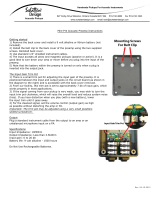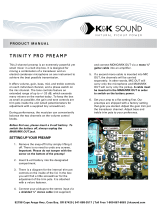
INPUT GAIN
Like the trim control on a pro-audio mixer, the input gain accommodates a
wide variety of incoming signal levels. For the cleanest possible signal,
adjust the input gain so that the clip/low battery LED barely flickers with
strong playing. If the LED lights up brightly as you play, your bass signal
is overdriving the circuit and you will hear distortion. Keep an eye on the
clip LED (and reset the input gain if necessary) when you make
adjustments to the depth, tone or compression settings.
CLIP / LOW BATTERY LIGHT INDICATOR
This light has three distinct functions:
1. Power Up Indicator
The LED flashes briefly when you plug into the input - it is telling you that
the unit is powering up.
2. Clip Indicator
Flashes brightly when your bass signal overloads the preamp. Adjust the
input gain so that the clip LED barely flashes with strong playing.
3. Low Battery Warning
When the red LED lights with no signal present it is time to change the
battery. If the low battery light comes on while you're playing don't worry,
you'll have enough power to get through a gig (at least 4 hours).
VOLUME
For the cleanest sound, set the volume as high as you can without
distorting your amp or mixer.
COMPRESSION
This allows you to alter the attack, sustain and dynamics of your bass. Set
the input gain before you turn on the compressor (compression is off at
7:00).
For you players who have given up on compression for bass, we feel your
pain. We spent months developing and refining a one knob photo-optic
compressor just for bass. With it you can dial up more punch, attack, and
sustain without any of the "pumping" or "squashing" that plagues other so
called "bass" compressors.
Compression is a useful tool for bass, especially for recording. But if
you've ever used it onstage you probably know that a poorly designed or
improperly set up compressor can completely screw up your live bass
sound. Recognizing the common shortcomings of "bass" compressors, we
designed our soft-knee photo-optic compressor to set up quickly and
sound good right out of the gate.
For slap and other aggressive playing styles, the Platinum Bass'
compressor does not strangle your highs. We deliberately placed it in the
signal chain before the bass and treble controls so you can boost without
squashing these important frequencies. Plus we carefully fine tuned the
compressor to complement the attack and sustain characteristics of bass
instruments.
Note:
As you raise the compression level, the apparent volume will
drop, due to the gain reduction of the compressor. Compensate for
this by raising the volume knob on the Platinum Bass
proportionately as you raise the compression level.
To gently smooth out your instrument's all-around response, set the
compression between 8:00 and 11:00.
For more punch set the compression between 12:00 and 2:00. This is
especially effective for tumbao and walking bass styles.
Solid rock bass tone: Boost the low mids with the compressor set around
12:00.
For heavy compression with lots of sustain set the compression knob
between 3:00 and 5:00 (for best results set the input gain as high as
possible, lighting the red clip light occasionally). You will find that this
works well for bass-synth effects, especially with an octave pedal placed
after the Platinum Bass preamp.
DEPTH
Tighten up your sound, or dial out deep-bass feedback with the depth
control. The depth control works hand in hand with the Bass control to
bring out tight and articulate lows.:
1.
Start with the depth turned up full (5:00) with the EQ set flat on your
bass, bass amp and/or PA.
2.
Set the bass slider to full boost.
3.
Play the bass and back off the Depth (counter-clockwise) until you hear
the sound tighten up, usually between 9:00 and 12:00.
4.
Re-set the bass slider to taste.
In addition to cleaning up your low end, the depth control will let your power
amp work more efficiently and provide protection for your speakers. When
set below 1:00, the depth control gets rid of the power-gobbling sub-sonic
stuff that taxes both your amp and speakers (not to mention your ears).
Depth control Tone tips:
A good place to start with the depth control is usually at about 10:00 In this
position you can max the bass control without losing articulation and mid-
bass attack.
For electric bass in rooms that absorb a lot your low end (e.g. a "dead"
room with curtains, upholstered furniture or carpeted floors), set the depth
to the higher positions; between 2:00 and 5:00.
To get rid of low frequency feedback with acoustic bass, sweep the depth
knob counter-clockwise until the feedback goes away (usually between 8:00
and 10:00).
For extremely difficult acoustic environments such as gymnasiums or high
ceiling rooms with reflective surfaces, set the depth to 9:00 or lower.
PHASE SWITCH
Use the Phase switch in combination with the Depth control to suppress
feedback for upright bass and acoustic bass guitar.
Electric bassists (solid body) can ignore this section -just leave the phase
switch in either position and go!
Unlike electric bass, acoustic bass tends to feedback when you amplify it
at high volumes. Feedback generally occurs in two different ranges: deep-
bass feedback (open D and below) and mid-bass feedback (above open
G).
-3-










